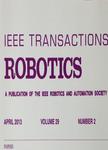版权所有:内蒙古大学图书馆 技术提供:维普资讯• 智图
内蒙古自治区呼和浩特市赛罕区大学西街235号 邮编: 010021

作者机构:Univ Michigan Dept Mech Engn Ann Arbor MI 48109 USA Harvard Univ John A Paulson Sch Engn & Appl Sci Cambridge MA 02138 USA Univ Stuttgart Inst Nonlinear Mech D-70174 Stuttgart Germany
出 版 物:《IEEE TRANSACTIONS ON ROBOTICS》 (IEEE机器人学汇刊)
年 卷 期:2021年第37卷第3期
页 面:948-961页
核心收录:
学科分类:0808[工学-电气工程] 08[工学] 0811[工学-控制科学与工程]
基 金:National Science Foundation Graduate Research Fellowship Program National Science Foundation Toyota Research Institute (TRI) Naval Research [N00014-18-1-2575] Directorate For Engineering Funding Source: National Science Foundation Div Of Civil, Mechanical, & Manufact Inn Funding Source: National Science Foundation
主 题:Robots Soft robotics Predictive models Predictive control Aerospace electronics Task analysis Delays Koopman operator model learning for control optimal control soft robots
摘 要:Controlling soft robots with precision is a challenge due to the difficulty of constructing models that are amenable to model-based control design techniques. Koopman operator theory offers a way to construct explicit dynamical models of soft robots and to control them using established model-based control methods. This approach is data driven, yet yields an explicit control-oriented model rather than just a black-box input-output mapping. This work describes a Koopman-based system identification method and its application to model predictive control (MPC) design for soft robots. Three MPC controllers are developed for a pneumatic soft robot arm via the Koopman-based approach, and their performances are evaluated with respect to several real-world trajectory following tasks. In terms of average tracking error, these Koopman-based controllers are more than three times more accurate than a benchmark MPC controller based on a linear state-space model of the same system, demonstrating the utility of the Koopman approach in controlling real soft robots.